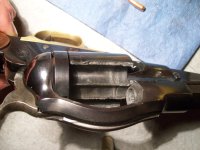CaptainCrossman
Moderator
I stumbled across this today, obviously these have been out for a while, Buffalo Arms carries them.
Colts and Remingtons w/forged steel frames- stronger than the cast steel frames, but not quite as strong as stainless steel or chrome moly steel.
but a step in the right direction regardless- see, this is why it pays to call these imports on the carpet and keep them honest, about making brass frame guns, and soft steel guns that shoot loose. They get the message and will respond with better metallurgy in their products.
yes, they cost more- the 1851 Navy is $317- but you're getting a "real" gun
http://www.buffaloarms.com/browse.cfm/4,5170.html
Possible Shop has all Uberti cap/ball pistols now listed as "forged steel frame"- this is a leap forward in quality over a brass frame, or cast steel frame
http://possibleshop.com/pistol-uberti.html
I'd wager that's why they "clearanced" all those "1851 Navy 44" guns at $179, to make way for higher quality forged steel guns
one problem remains- if the barrels are not forged steel, the guns will still shoot loose because the wedge/barrel slot will peen and deform
they're still cutting corners, but we're getting there...slowly...why not make the frame, barrel, and wedge forged steel and be done with it ?
Colts and Remingtons w/forged steel frames- stronger than the cast steel frames, but not quite as strong as stainless steel or chrome moly steel.
but a step in the right direction regardless- see, this is why it pays to call these imports on the carpet and keep them honest, about making brass frame guns, and soft steel guns that shoot loose. They get the message and will respond with better metallurgy in their products.
yes, they cost more- the 1851 Navy is $317- but you're getting a "real" gun
http://www.buffaloarms.com/browse.cfm/4,5170.html
Possible Shop has all Uberti cap/ball pistols now listed as "forged steel frame"- this is a leap forward in quality over a brass frame, or cast steel frame
http://possibleshop.com/pistol-uberti.html
I'd wager that's why they "clearanced" all those "1851 Navy 44" guns at $179, to make way for higher quality forged steel guns
one problem remains- if the barrels are not forged steel, the guns will still shoot loose because the wedge/barrel slot will peen and deform
they're still cutting corners, but we're getting there...slowly...why not make the frame, barrel, and wedge forged steel and be done with it ?
Last edited:


